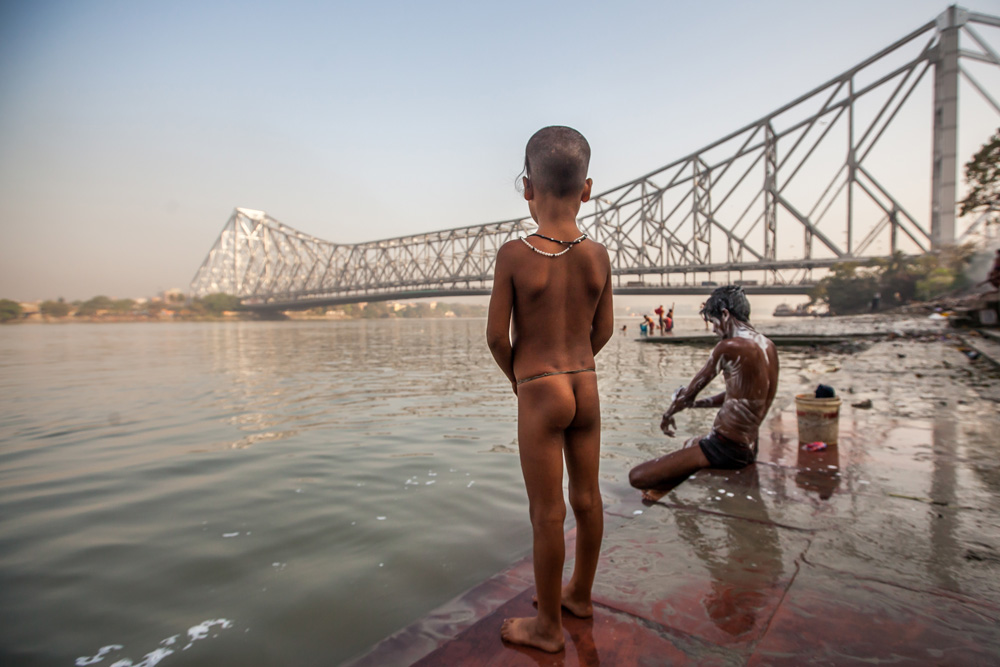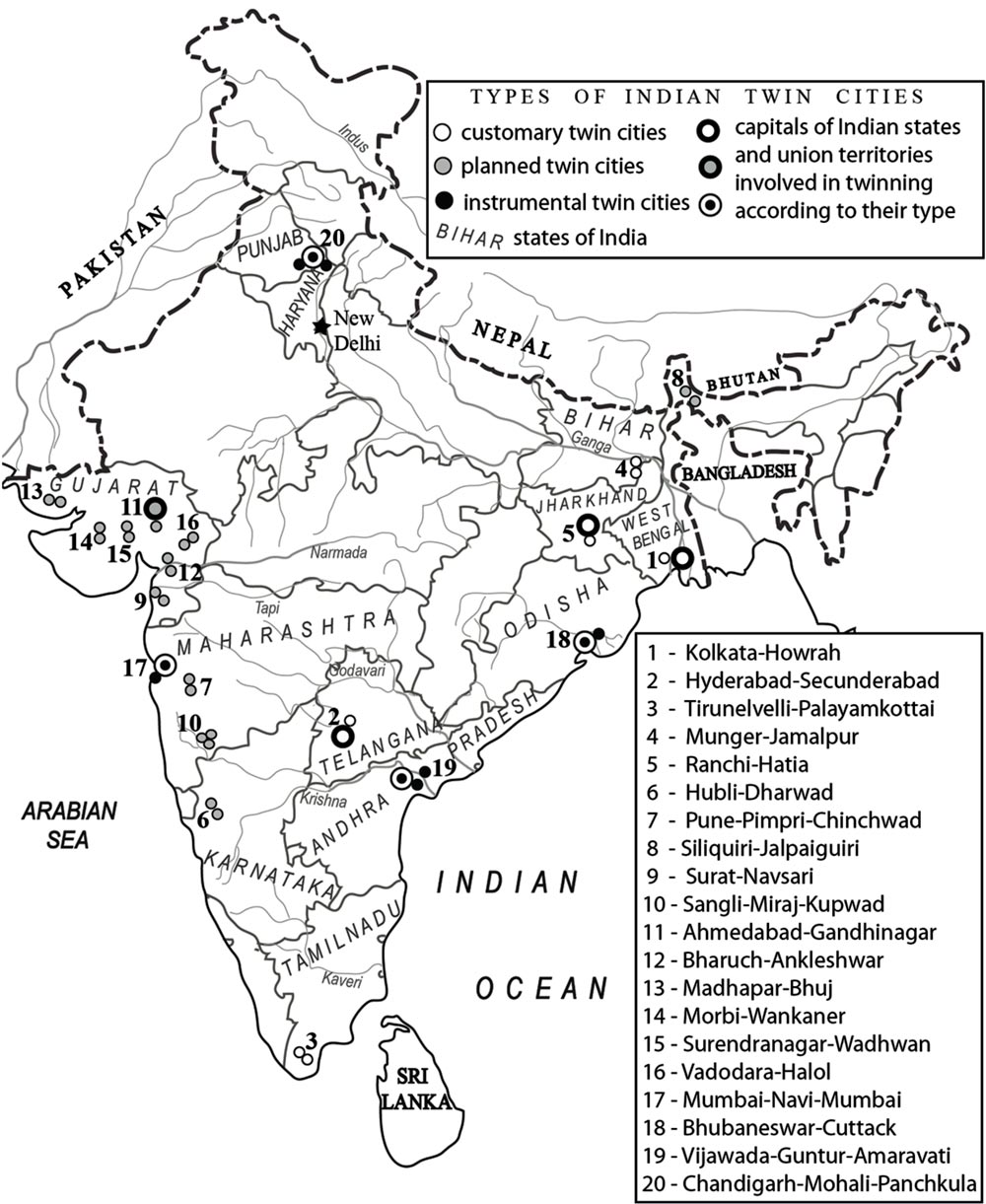Although highly, indeed increasingly, important features of its cityscape, India’s twin cities have apparently attracted little scholarly attention. We will try to remedy some of that deficiency by drawing on the copious material available from public sources to assess the following: the context wherein twin cities arise; their characteristics and underpinning intentions; and, as far as possible, their impact and outcomes.
Context and Causes
India’s interest in twin cities and the shape it has taken must be set against key features of the background wherein they arise: most notably, the burgeoning and apparently chaotic character of urban growth, the propensity for planned responses to that growth, party-political vibrancy at national and state levels, and most recently the downward trajectory of political mobilisation.
Most significant has been rapid and accelerating urbanisation, based on inward rural migration at least as much as self-generation, plus perceptions (albeit somewhat inaccurate) that governmental and urban elites have been little more successful at handling the consequential poverty, overcrowding, burgeoning slums, insanitation and ill-health than their European and American predecessors in relation to similarly generated problems in the 19th century. This perception holds, even though – partly because of that previous experience – problems have been recognised far earlier in the urbanisation cycle; and the understanding and remedies are more potentially effective. Furthermore, India’s urbanisation level is lower than many other Asian countries, even if the costs sometimes seem greater.
Painfully acute urban problems are hardly particular to India, being evident across much of industrialising Asia, Africa and Latin America. The commonest cross-continental answer has long been urban (and rural) planning, even if only sometimes enacted. What has distinguished India has been the increasing belief since the 1960s that the highly managed twinning of relatively nearby cities represents a crucial (though obviously not the only) part of that remedy. The twin city idea has become an important way of thinking about urban planning, a potent symbol of modernity. Partly in consequence, pledges about new twin cities ultimately benefiting all have become increasing features of party-political discourse at local, state and federal levels, thereby enhancing twin city generation. Narendra Modi, both as Gujarat Chief Minister (announcing no fewer than five twinned creations in December 2011) and more recently as Indian Prime Minister (twin cities and satellite towns being prominent in the BJP election manifesto of July 2014) has been notably active here – all in his constantly stated belief that cities drive economic growth and provide enduring opportunity to mitigate poverty.
As implied, further fuelling but also complicating this ambiguous but ultimately positive perception of urbanisation, and Indian responses to it, has been vibrant party rivalry – at city, state and federal levels – and the connected fact that the Congress Party’s post-Independence hegemony has collapsed completely. This has enhanced the ever-present competitive tendency of democratic politicians to calculate less in terms of amorphous majorities than the perpetual appeasement of small groups (Dahl 1963). In the twin city context, this is evident in the ‘inclusion’ of multiple sorts of urban and rural victim groups in political debates on urban planning. This in turn has interacted with the fact that those victims’ groups in recent years have proved increasingly willing to mobilise on their own behalf.
Characteristics and Intentions
One broad consequence of these factors has been a large and increasing crop of Indian twin cities that are both like and dramatically unlike their intra-national counterparts elsewhere, indeed having more in common with cross-national twins. Indian twins are of two, arguably three, broad and hazily divided types. First, there are pairings whose cities have either grown into each other in the classic twin city sense, or started that way on opposite riverbanks, and have come to be commonly seen as twins: all the more for being frequently so labelled on the internet. In what follows, we draw material from the following contrasting pairs: 1) Hyderabad (currently joint capital of the states of Telangana and Andhra Pradesh) and Secunderabad, separated from each other by the Hussain Sagar Lake; 2) Kolkata (West Bengal’s capital) and Howrah, separated by the Hoogli River; 3) Tirunelvelli and Palayamkottai in Tamil Nadu state, divided by the Tamirabarani river; and 4) Munger and Jamalpur in poverty-stricken Bihar state, separated only by a shrinking strip of land.
Second, there are large and increasing numbers of often-quite-distant cities whose twinning has been formally declared, often legislatively enabled, and coordinated and increasingly planned. This recognition has normally been at state, and sometimes federal (Ministry of Urban Affairs), level. The purpose has been either to take control of two merging cities thought likely to collide in the classic sense, thereby not just avoiding unplanned chaos but also making economically beneficial use of their ever-shrinking hinterland and their supposed complementarity, or, alternatively, to hitch a smaller and poorly-performing entity to a larger and more vibrant city nearby to the supposedly mutual benefit of both. We shall draw evidence for planned twins from Hubli-Dharwad in Karnataka; Sangli-Miraj (with Kupwad) and Pimpri-Chinchwad arguably with Pune (in Maharashtra); and Surat-Navsari, Ahmedabad-Gandhinagar, Morbi-Wankaner, Vadodara-Halol and Bharuch-Ankleshwar all in Gujarat state. Our decision to draw heavily on Gujarat is deliberate: it is one of India’s most economically vibrant and proudly urbanising states and, partly due to the presence of its combative BJP Chief Minister Narendra Modi 2001-14, it assumed an almost messianistic role in championing both ‘the twin-city model’, and his more general underpinning view that urbanisation is a positive and socially inclusive economic force.
This type morphs into what is arguably a third instrumental twinned category: to facilitate some purpose, like creating a new state capital as in Gujarat, Orisha and Andhra Pradesh, or a pressure-relieving satellite, as with Mumbai and highly planned Navi Mumbai across Thane Creek in Maharashtra.
Impact and Consequences
Short-term impacts are relatively easily traceable. They occur in the wake of publicly promised twinning. Very common are signs of anticipatory excitement in the real-estate sector located in and around the hinterland between projected twins. Thus, as twinning plans hardened for Surat-Navsari during September 2013, the TOI reported that their hinterland seemed ‘to be turning into a goldmine for developers’ with district authorities subject to ‘a deluge of applications for conversion of huge chunks of agricultural land’ for ‘commercial and residential purposes’ (TOI 3 September 2013). Magicbricks (7 May 2014), a real-estate publication, showed comparable salivation in May 2014, reporting that ‘Ahmedabad’s property picture is very bright…the city is dragging its sister city on the same lines of boom, making Gandhinagar…one of the most viable options for property investment in recent times’ – doubly so as rapid-transit plans began making the hinterland ever more appetising. However, other groups show less enthusiasm about twin-city inclusion. Agriculturalists are often understandably ambivalent – as evident in Bharuch-Ankleshwar, where conflict with building interests has paralysed twinning plans at the point of writing. Equally in Morbi-Wankaner: here, rural perceptions that urban inclusion brought few of the promised benefits, like affordable housing, sewage disposal, etc., while rendering agricultural pursuits harder led the Gujarat state government to exclude several villages from the joint Urban Development Authority’s territory. One almost invariable medium-term consequence of planned Indian twinning is the development, at a minimum, of major highways through or around the twinned area. Besides being bicycle-friendly, this is often accompanied by the emergence of plans for bus and/or tram-based rapid-transit systems (BRTS) linking the two, seen as crucial if the projected benefits of partnership regarding labour mobility, hinterland development, access to each other’s facilities, etc. are to become real. Indeed, without this, citizens have no reason to think the twinned neighbour more important than anywhere else nearby. And if twinning benefits are to extend downwards, BRTS must be cost-accessible.
Equally important are governance changes. These vary, perhaps confirming a World Bank criticism of urban India for the unpredictable variability of its local-governmental provision. Sometimes recognising interdependence has entailed the early formation of joint municipalities, as with Hubli-Dharwad (1925 reinforced in 1962) Pimpri-Chinchwad (1970 and more powerfully 1982) and Sangli-Miraj (1998-9). These may be supplemented by joint urban development authorities, as with Hubli-Darwhad from 1987. Sometimes separate municipalities have been retained but supplemented by joint urban development authorities. Sometimes joint municipalities alone appear to have been deemed sufficient to oversee twin city relationships.
All these authorities are involved in producing and implementing twin city planning. The rough principle seems to be that UDAs are responsible for constructing long-term plans, negotiating details with municipalities and all levels of stakeholders, then submitting the agreed result to relevant state ministries for final approval.
Planning is central to Indian contemplations of urban areas, but three aspects may have special pertinence to twin city planning. First, the need to exploit the perceived strengths of both partners for the general communal good. This is most easily illustrated by the Vision statement in Hubli-Dharwad’s Revised City Development Programme 2041 (RCDP). Contemplating a twin city, wherein Hubli was the major commercial and business centre and Dharwad the major administrative (for its District) cultural and educational centre, it envisaged the two becoming North Karnataka’s ‘commercial, cultural and educational hub’ and creating ‘an opportunity for growth to all segments of people’ (RCDP Executive Summary, 2).
Second, planned twins need to exploit and develop their mutual hinterland. Thus, the aforementioned plan aimed primarily at ‘growth along the Hubli-Dharwad highway’, particularly in the light of BRTS development (ibid.). This is often seen as central to such aims, not just by planned twins but by the evolving unplanned twins we have classified as type 1, though, in both cases, this partly depends on distance apart.
Third, given the above need, twin cities often experience heightened needs to negotiate plans not just with urban groups but with the many rural groups and individuals located in their frequently extensive hinterland of villages. The relationship is ambivalent. As noted with Surat-Navsari, some villages can successfully resist inclusion within a projected joint UDA on the grounds that urban benefits are not all they are claimed to be. If included, the dilemmas on both sides become clear. Sangli-Miraj contains much agricultural land, which, as of 2007, comprised 48.59% of the total municipal area. Furthermore, ‘this land is precious and productive…hence it cannot be brought under…urban use.’ Yet, while limiting urban expansion, agriculture engaged just 10% of the workforce (IJRFR 3, 7 March 2016).













